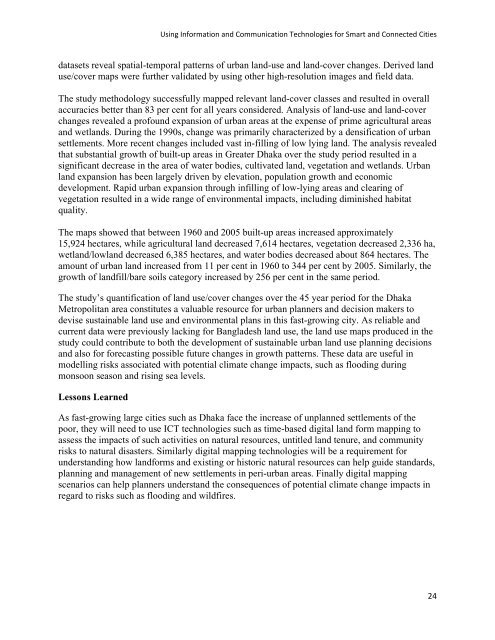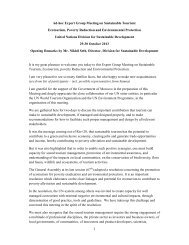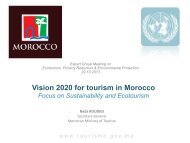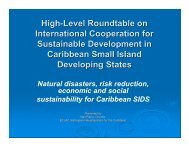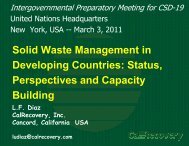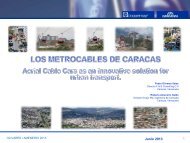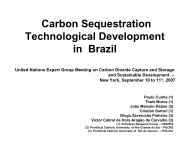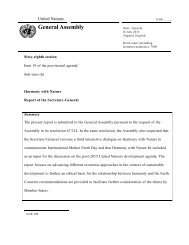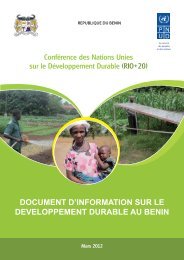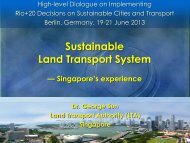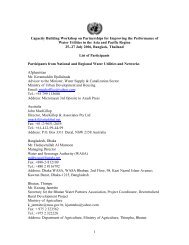A Guide for Sustainable Urban Development of the 21st Century
A Guide for Sustainable Urban Development of the 21st Century
A Guide for Sustainable Urban Development of the 21st Century
Create successful ePaper yourself
Turn your PDF publications into a flip-book with our unique Google optimized e-Paper software.
Using In<strong>for</strong>mation and Communication Technologies <strong>for</strong> Smart and Connected Citiesdatasets reveal spatial-temporal patterns <strong>of</strong> urban land-use and land-cover changes. Derived landuse/cover maps were fur<strong>the</strong>r validated by using o<strong>the</strong>r high-resolution images and field data.The study methodology successfully mapped relevant land-cover classes and resulted in overallaccuracies better than 83 per cent <strong>for</strong> all years considered. Analysis <strong>of</strong> land-use and land-coverchanges revealed a pr<strong>of</strong>ound expansion <strong>of</strong> urban areas at <strong>the</strong> expense <strong>of</strong> prime agricultural areasand wetlands. During <strong>the</strong> 1990s, change was primarily characterized by a densification <strong>of</strong> urbansettlements. More recent changes included vast in-filling <strong>of</strong> low lying land. The analysis revealedthat substantial growth <strong>of</strong> built-up areas in Greater Dhaka over <strong>the</strong> study period resulted in asignificant decrease in <strong>the</strong> area <strong>of</strong> water bodies, cultivated land, vegetation and wetlands. <strong>Urban</strong>land expansion has been largely driven by elevation, population growth and economicdevelopment. Rapid urban expansion through infilling <strong>of</strong> low-lying areas and clearing <strong>of</strong>vegetation resulted in a wide range <strong>of</strong> environmental impacts, including diminished habitatquality.The maps showed that between 1960 and 2005 built-up areas increased approximately15,924 hectares, while agricultural land decreased 7,614 hectares, vegetation decreased 2,336 ha,wetland/lowland decreased 6,385 hectares, and water bodies decreased about 864 hectares. Theamount <strong>of</strong> urban land increased from 11 per cent in 1960 to 344 per cent by 2005. Similarly, <strong>the</strong>growth <strong>of</strong> landfill/bare soils category increased by 256 per cent in <strong>the</strong> same period.The study’s quantification <strong>of</strong> land use/cover changes over <strong>the</strong> 45 year period <strong>for</strong> <strong>the</strong> DhakaMetropolitan area constitutes a valuable resource <strong>for</strong> urban planners and decision makers todevise sustainable land use and environmental plans in this fast-growing city. As reliable andcurrent data were previously lacking <strong>for</strong> Bangladesh land use, <strong>the</strong> land use maps produced in <strong>the</strong>study could contribute to both <strong>the</strong> development <strong>of</strong> sustainable urban land use planning decisionsand also <strong>for</strong> <strong>for</strong>ecasting possible future changes in growth patterns. These data are useful inmodelling risks associated with potential climate change impacts, such as flooding duringmonsoon season and rising sea levels.Lessons LearnedAs fast-growing large cities such as Dhaka face <strong>the</strong> increase <strong>of</strong> unplanned settlements <strong>of</strong> <strong>the</strong>poor, <strong>the</strong>y will need to use ICT technologies such as time-based digital land <strong>for</strong>m mapping toassess <strong>the</strong> impacts <strong>of</strong> such activities on natural resources, untitled land tenure, and communityrisks to natural disasters. Similarly digital mapping technologies will be a requirement <strong>for</strong>understanding how land<strong>for</strong>ms and existing or historic natural resources can help guide standards,planning and management <strong>of</strong> new settlements in peri-urban areas. Finally digital mappingscenarios can help planners understand <strong>the</strong> consequences <strong>of</strong> potential climate change impacts inregard to risks such as flooding and wildfires.24


